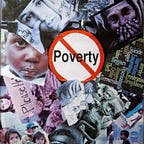What can YOU do to stop Poverty?
Each year on October. 17, we mark End Poverty Day at the World Bank Group to celebrate the progress we’ve made toward our twin goals: to end extreme poverty by 2030; and to boost shared prosperity among the poorest 40 percent around the world. But more importantly, we use this day to take stock of how much further we have to go.
Today, we released the latest Poverty and Shared Prosperity Report, which shows that we have never been closer to realizing those goals.
The percentage of the global population living in extreme poverty has dropped from 36 percent in 1990 to 10 percent in 2015, the lowest it has ever been in recorded history.
During that time, more than 1 billion people lifted themselves out of poverty. About half of the world’s countries have reduced extreme poverty below 3 percent — the target we set for the world to reach by 2030.
This is one of the great achievements of our time, but 736 million people still live in extreme poverty — that’s living on less than $1.90 a day. The pace of poverty reduction is also slowing. According to World bank.org, “Globally, poverty shrank by just over 1 percentage point between 2013 and 2015, half as slowly as between 2011 and 2013. To reach our goal of bringing extreme poverty below 3 percent by 2030, the world’s poorest countries will have to grow at rates that far surpass their historical experience (We need to step up our efforts to end poverty in all of its dimensions, 2018).”
The SDGs’ main reference to combatting poverty is made in target 1.A: “Ensure significant mobilization of resources from a variety of sources, including through enhanced development cooperation, in order to provide adequate and predictable means for developing countries, in particular least developed countries, to implement programmes and policies to end poverty in all its dimensions.”
The SDGs also aim to create sound policy frameworks at national and regional levels, based on pro-poor and gender-sensitive development strategies to ensure that by 2030 all men and women have equal rights to economic resources, as well as access to basic services, ownership and control over land and other forms of property, inheritance, natural resources, appropriate new technology and financial services, including microfinance.
Government assistance programs were particularly important in keeping children out of poverty. As shown in Figure B, of the 8.3 million Americans that refundable tax credits lifted out of poverty, 4.5 million were children. Similarly, of the 3.4 million Americans that SNAP kept out of poverty, 1.5 million were children. Housing subsidies shielded almost 900,000 children from poverty. Even Social Security — too often thought of as strictly a program for older Americans — has a large impact on the welfare of children, lifting 1.4 million kids above the poverty line.
There are many other ways, on the big scale, that the world can do towards reducing poverty. For example, increasing employment, raising pay, immigration reform, and ending poverty tax.
Although, there are also many actions that YOU can take towards ending poverty. For example, you can create awareness. Social media has become an integral part of daily life, and now is the time to use it as a voice of social good. Sharing links on Facebook, Twitter, and other platforms will allow people to learn more about global poverty and will increase the general consciousness of the issue. You could also donate. Donations can help in so many ways. They do not always have to take the form of money. This can include donating books to a poor child or buying groceries for a poor family for a week to help fight hunger. Donating old clothes, furniture and toiletries can also help improve the well-being of the poor.
Resources
We need to step up our efforts to end poverty in all of its dimensions. (2018, October 17). World Bank Blogs. https://blogs.worldbank.org/voices/we-need-step-our-efforts-end-poverty-all-its-dimensions
United Nations. (2020). Ending Poverty | United Nations. United Nations; United Nations. https://www.un.org/en/global-issues/ending-poverty
Government programs kept tens of millions out of poverty in 2017. (2017). Economic Policy Institute. https://www.epi.org/blog/government-programs-kept-tens-of-millions-out-of-poverty-in-2017/
9 Ways to Reduce Poverty. (2015). The Raising of America. https://raisingofamerica.org/9-ways-reduce-poverty#:~:text=Strengthening%20existing%20programs%20like%20unemployment,household%20income%20and%20protect%20children.
Borgen Project. (2018, May 8). How to Stop Poverty: Seven Effective Actions | The Borgen Project. The Borgen Project. https://borgenproject.org/how-to-stop-poverty-actions/
TED. (2021). The quest to end poverty. Ted.com; TED Talks. https://www.ted.com/playlists/67/the_quest_to_end_poverty
Hearts and Minds Volunteers. (2019, October 11). New Ways to End Poverty. Hearts and Minds®; Hearts and Minds. https://www.heartsandminds.org/media/new-ways-to-end-poverty/
